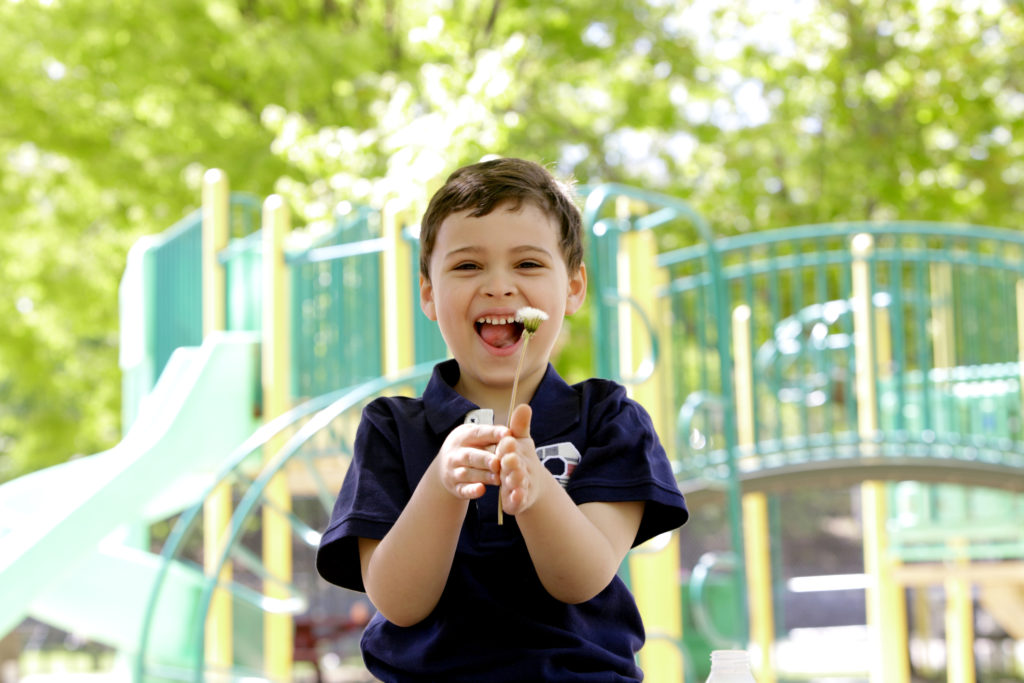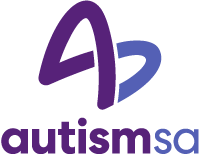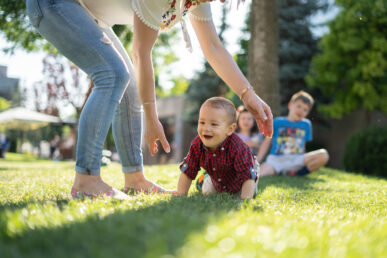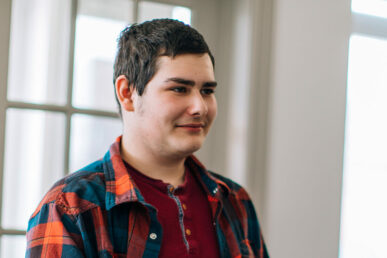Autism First Signs: A Checklist for Children

Signs of autism in children
When children begin school, there is a lot for them to take in — a new environment, new routines, new peers — and so it can be a challenging time all round.
This is why children are often diagnosed as being on the spectrum at the outset of their education or during their early school years. The various and never-ending demands of a school day can highlight that a child with autism is developing differently in terms of their social communication and interaction skills, or in their behaviour, interests and activities.
Parents and carers who have not noticed any characteristics of autism in their baby or toddler, or have observed some signs but have not reached out to a health care professional, may begin to see characteristics more distinctly when a child on the spectrum begins school. Additional characteristics of autism may also begin to be observed, either by you, teachers or other parents.
“The various and never-ending demands of a school day can highlight that a child with autism is developing differently…”
You might, for instance, notice that your child is finding it difficult to forge friendships or engage in conversations. They may become intensely focussed on a subject or object, or are finding it difficult to follow instructions.
While it is important to recognise that all children develop at different rates, there are nevertheless characteristics of communication and behaviour that can signal that a child is on the spectrum.
If your child displays some of the characteristics of autism outlined below, it could be that they are on the spectrum (it is very unlikely that they will have all of them). In this case, you should seek the advice of a GP, nurse or health worker, as only a qualified professional can provide a diagnosis of autism.
It is also possible to self-refer and make arrangements for an assessment with Autism SA directly.
In either case, it is important to remember that these checklists are simply a guide, and that a diagnosis of autism can only be made by a qualified professional.
While it is important to recognise that all children develop at different rates, there are nevertheless characteristics of communication and behaviour that can signal that a child is on the spectrum.
Characteristics of autism in children of primary school age checklist
Autism in children of primary school age may be indicated by the display of characteristics in two domains:
- Social communication and social interaction
- Repetitive or restricted behaviour, interests or activities
If your child displays some of the characteristics detailed below, you should consult with a qualified healthcare professional.
Social communication and social interaction
Children with autism will often communicate differently or in unexpected ways with others. Some examples of these characteristics may include:
- A tendency to dominate conversations in which they are taking part, or to have trouble taking turns.
- Intense conversational focus on subjects that interest them, combined with a reluctance to engage in conversations on other topics.
- Speaking in unexpected or unusual ways, e.g., very formally or very informally, in a monotone, in an accent, etc.
- Some children on the spectrum may develop only limited speech, or remain non-speaking.
- Difficulty in responding to the tone of voice being used by others, or to non-verbal social cues such as facial expressions and body language.
- Difficulty in following conversations, with a tendency not to pick up on non-literal language like sarcasm or metaphor.
- Displaying a limited range of facial expressions, or using facial expressions that don’t match what a person is communicating.
- Difficulty in making or maintaining eye contact with others.
- Difficulty in following instructions that contain more than one or two steps.
- Talking about their feelings or answering questions about themselves can be difficult.
- Not responding consistently to their name, or referring to themselves as ‘you’ rather than ‘I’.
- Trouble initiating interactions with other children, or developing and maintaining friendships with peers.
- A tendency to try to dominate play when engaging with others.
- A preference for spending time with younger children or with adults, rather than with children of the same age.
- A tendency to prefer playing on their own rather than playing with others, or avoiding group activities.
- May be reluctant to develop close friendships.
- Rigidity with regard to setting and following rules, whether in the classroom or during play.
- Difficulty in recognising other people’s personal space.
Repetitive or restricted behaviour, interests or activities
Children on the spectrum can display unique or unexpected behaviours. These may include:
- An intense focus on unusual hobbies, such a keeping lists or memorising statistics, or on objects like toys, household objects or more unusual objects.
- Repetitive behaviour, such as arranging objects or toys in a precise, unchanging way.
- Repeating words or phrases constantly.
- Extreme sensitivity to a range of sensory experiences. For instance, they may object to wearing clothes made from certain fabrics, hate loud noises, or only eat certain foods based on their texture. A sensory overload can in some children provoke extreme reactions.
- Not responding to some sensory experiences, such as heat, cold or pain.
- Closely following routines, and getting upset when plans change or routines aren’t followed.
- Feeling anxious or upset when in social situations with which they aren’t familiar.
- Finding it difficult to solve problems or apply skills they have learnt in different contexts.
- Feeling overwhelmed or upset about going to school, or regularly refusing to go.
- Making unusual body movements, such as hand clapping, hand flapping or rocking.
- Finding it difficult to sit, stand or be still, or constantly fidgeting.
- Making unusual noises such as grunts or squeals, or frequently clearing their throat.
- Sleeping patterns that are irregular, such as staying awake long after bedtime, or waking up frequently during the night.

Signs of autism in teenagers
Teenagers can face a variety of challenges when trying to navigate daily life — a mix of academic expectations, the pressing need to negotiate the intricacies of peer groups and social media, and trying to stay fit and healthy, can all create untold pressures that can make life difficult.
Adolescence can be especially challenging for teenagers on the autism spectrum.
In particular, it can be a daunting time for a teenager on the autism spectrum who hasn’t been diagnosed, as they might not be able to understand the way they respond to the people around them, or be able to grasp why they are developing differently to their peers. This can create anxiety and confusion, or cause young people to feel distressed or angry, without necessarily knowing why.
While everyone’s experience of living with autism is unique, there are nevertheless characteristics that teenagers on the spectrum are likely to display. It can, however, be difficult for parents and carers to recognise whether these behaviours are just teenage traits, or whether they are signs of autism.
Parents and carers may recognise characteristics associated with autism in teenagers in two domains:
- Social communication and social interaction
- Repetitive or restricted behaviour, interests or activities
Not all of these characteristics will be displayed by a teenager on the spectrum, while some may appear or develop as they get older.
Social communication and social interaction
Communicating with peers and adults, developing friendships and creating support networks can be vital for teenagers, both in school and out, but these can be challenging for teenagers with autism. Some signs that teens may be on the spectrum may include:
- Difficulty in maintaining conversations, either through trying to dominate the talk at the expense of others, having problems staying on topic, responding to questions, or talking about themselves
- Having trouble making and maintaining eye contact with others
- Becoming intensely focussed on topics in which they are interested, to the exclusion of other subjects they are not interested in
- Difficulty in noticing, reacting or responding to non-verbal social cues, such as tone of voice or body language. This can make it difficult for people on the spectrum to understand non-literal uses of language, such as sarcasm, figures of speech, etc
- Difficulty in picking up on the facial expressions of others, meaning that they often have unexpected responses, or appear to lack empathy for the feelings of others
- Teenagers with autism may have a limited range of facial expressions, respond with unexpected expressions, or show no reactions
- Difficulty in understanding or maintaining the concept of personal space in their interactions with others
- It can be challenging for teens with autism to understand the unwritten rules of friendship, and so they can become isolated as a consequence
- Teenagers on the spectrum may also prefer to be friends with adults or younger children, rather than their peers
- A tendency to want to dominate activities in which they are participating, and difficult in taking turns
- Inflexibility when it comes to rules and routines, at school, at home or in social situations, and becoming upset if they are not followed or changed
- Speaking in an unusual manner, such as in a monotone, with an accent, extremely formally or very informally
- Some teenagers on the spectrum may speak very little or not at all
- Difficulty in following instructions that require more than a few steps.
Repetitive or restricted behaviour, interests or activities
A teenager on the autism spectrum may display repetitive or restricted behaviours, including:
- Adhering strictly to routines and becoming distressed when they change or are not followed
- Becoming upset or anxious when faced with new social situations, or being taken to places with which they are unfamiliar
- Regularly refusing to go to school when they are feeling anxious, upset or confused
- Becoming intensely interested in unusual hobbies, or forming very strong attachments to unexpected objects
- Difficulty in transferring their attention from one activity to another, particularly if it is not something they have great interest in
- Repetitive behaviour, such as constantly putting objects into groups or lining them up
- Exhibiting a high degree of sensitivity to sensory experiences, such as refusing to wear certain fabrics, becoming distressed by certain sounds, or only eating foods with a particular texture
- Some teenagers on the spectrum can develop eating disorders when feeling anxious or at times of significant stress
- Not responding to some sensory stimuli, such as heat, cold or pain
- Sensory overload can lead to unexpected responses or behaviours
- Performing unusual or unexpected body movements, such as flapping their hands, rocking, or flicking their fingers
- Making unusual or unexpected noises and sounds, such as grunting, squealing or constantly clearing their throat
- Unusual sleeping patterns, such as staying awake long into the night or waking up regularly at a particular time each night
- Feelings of isolation when they begin to understand that their development differs to their peers, and that this is beginning to be noticed by classmates and others
- Difficulty in being organised and managing their studies, friendships and other activities.

Should I get an autism assessment for my child?
If your school age child or teenager is displaying some of the characteristics of autism as outlined above, or is developing at a different rate to other children of their age, it is a good idea to seek some professional advice as early as possible.
Everyone’s experience of autism is unique and it is an individual’s choice to seek an autism assessment. For some families an autism diagnosis can lead to an increased understanding of the ways in which your child is developing and, if they receive a positive autism diagnosis, what sort of services and support may be available and of benefit.
If a person receives a diagnosis of autism it can lead to a greater understanding of themselves and their behaviours, and why they might be developing in a different way to their peers.
Teenagers with autism may also gain a greater sense of self-identify once they have a diagnosis, and identify that there are many other people their age who are on the spectrum, some of whom may have had relatively similar experiences to their own.
Being able to share a diagnosis with school can also mean that your child is able to get better support and have their learning needs met more effectively.
Getting an autism assessment
An autism assessment conducted by trained and qualified specialists in diagnosis will answer the question as to whether an individual is on the autism spectrum or not.
For many years Autism SA has provided autism assessments. Due to high demand we are not taking any new referrals at this time. We apologise for the inconvenience.
There are many Diagnosticians across South Australia. Please look at our Diagnosticians Directory and contact them directly to find out wait times and costs. Please note, the directory does not include all diagnosticians in the state.
Diagnostician directoryGet a copy of the ultimate resource: The Spectrum booklet
Autism SA is proud to launch The Spectrum: A Guide to Supporting a Child on the Autism Spectrum.
The booklet is designed to assist parents through the autism journey with four comprehensive sections: Understanding Autism, Getting an Autism Diagnosis, Supports and Services, and Strategies and Practices.
You can now purchase The Spectrum booklet for just $29.95. Buy now
Purchasing the PDF allows you to print off the booklet or select pages so you can keep a hard copy on hand when you are seeking practical, credible information about autism. Plus there are additional materials including templates and infographics.
Enquire about this article








